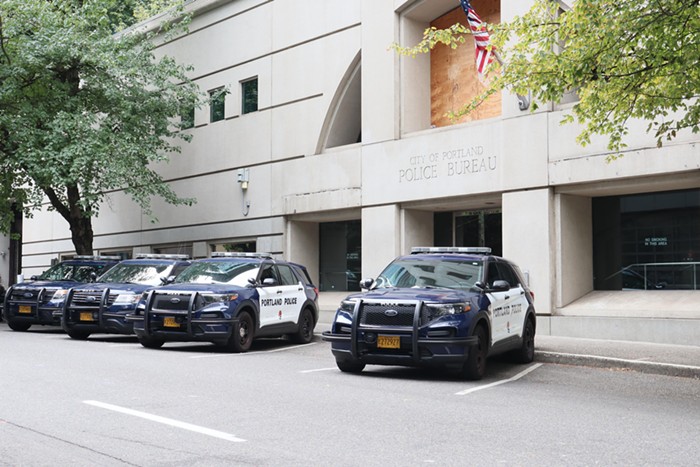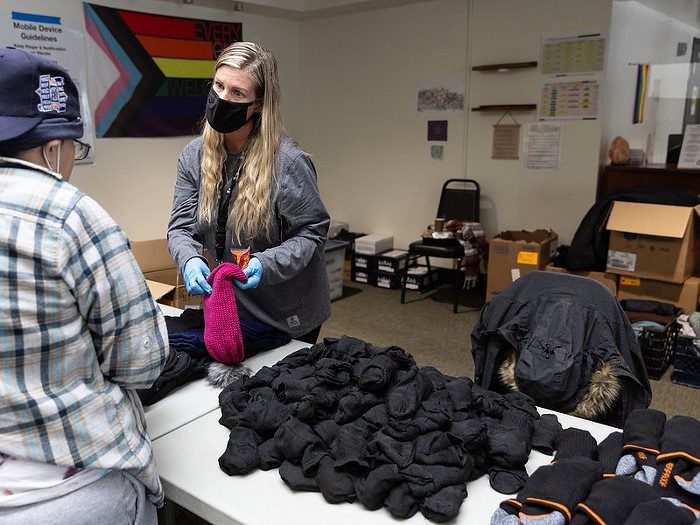THE EUPHEMISM you'll hear is "budget violation." But when Multnomah County Sheriff Dan Staton—with no warning to taxpayers—overshot his allotted funds by more than $500,000 last fiscal year, it amounted to a breach of Oregon law.
Now the sheriff has some explaining to do.
On Thursday, December 12, Staton's slated to appear before the county board of commissioners, the second time in two months he's been called to publicly account for his spending. And if county documents are correct, Staton will offer a familiar scapegoat: unexpected overtime costs.
The number of inmates who need to be watched for suicide in the county's jails has shot up, Staton says. Short-staffed, he's had no choice but to offer his employees extra shifts, a practice that's gained a certain measure of infamy in recent years.
But Staton—and the county commissioners who've criticized his spending—may be missing the point. According to a newly released report from the Multnomah County Auditor's Office, overtime isn't his problem.
In fact, Staton's liberal use of overtime—which in some cases has allowed employees to more than double already-ample salaries—is actually saving the county money, the new audit says. And the sheriff's continuing struggle to reach full staffing levels might be a good thing, fiscally.
What's actually causing year-over-year spending increases in the sheriff's office is a rising workload, mixed with a high level of vacation hours and sick time.
To solve the puzzle of Staton's expenses, the auditor's office says officials should forget overtime and look at the bigger picture.
"Misunderstandings about overtime have distracted attention from monitoring more expensive personnel costs such as additional work and absences," the audit says.
The finding is surprising, given the intense focus county officials have placed on Staton's numbers. This year, the board instituted a rule requiring the sheriff to appear every three months to request a disbursement of overtime money.
Commissioners have also questioned whether corrections staff can adequately do their jobs while working, in some cases, drastically increased hours. And they're troubled about such drastic spending at a time when the jail's increasingly been forced to release prisoners due to overcrowding.
It's easy to see where those concerns come from.
The sheriff's office accounts for more than 70 percent of the county's overtime hours, and more than 75 percent of total overtime spending. Stories emerge of employees working hundreds of hours, pushing their salaries to among the highest in the county.
At the same time, the sheriff's overtime budget has decreased each of the past three years, even as his overtime spending keeps going up. Last year's budget allotted more than $3.5 million for overtime costs. Staton spent $8.1 million, despite a slight decrease in actual overtime hours.From July through September of this year alone, a corrections officer named Jobie Marshall worked 431.5 overtime hours, banking nearly $25,600—about a third of her $75,112 base salary.
But the audit takes a relatively chipper view of the overtime spending. County Auditor Steve March says his staff found no solid proof that sheriff's office employees are worse off for working the extra hours—unplanned absences actually went down with more OT, according to one analysis. And the report found little evidence employees are gaming the system to improve their pension benefits.
And then there's this: Staffing one 24/7 post in the county jail costs, on average, $726,386. That number includes fixed health insurance costs, and the cost of paying other employees to cover that post for vacations and sick days. The same post, paid for in overtime—without a dedicated staffer—costs $712,609, the audit found.
"We looked 24 different ways, and it all added up to where overtime was slightly cheaper," March says.
Another finding: One hour of overtime costs $81.35, on average. If the sheriff's office were to fill its dozens of vacancies and wind up with more employees than it actually needed, those extras would cost more than $121 an hour.
But if Staton's recent "budget violation" shows anything, it's that his spending is still getting away from him, despite overtime's help. The sheriff's office budget has increased by nearly $10 million since the 2011 budget year, despite no increase in one of its main cost drivers, jail capacity. Corrections officers have logged an increase of more than 10,000 total work hours each of the last two years.
And while the sheriff's office has indicated some anecdotal underpinnings—increased suicide watch, hospital details for sick prisoners, and training new employees—it's not able to back those assertions up with concrete figures, March says.
Still, Chief Deputy Drew Brosh is able to offer some anecdotal numbers. For years, he says, the jail fluctuated between zero and two inmates on suicide watch at a time. It's now as high as 17.
"This last year it shot up pretty exponentially," says Brosh, who blamed the uptick for his office's budget mishap.
But Brosh couldn't explain the phenomenon. He noted jailers these days ask more questions to determine whether prisoners need to be monitored, but acknowledged that change was made years before the dramatic increase. "The face of the inmate is changing."
If the county hopes to get hold of the sheriff's runaway budget, it will need to better quantify its needs and budget for them more honestly in the future.
"They're doing more work," says March. "Now they need to come back and be able to say what they're doing to fill those hours."



















